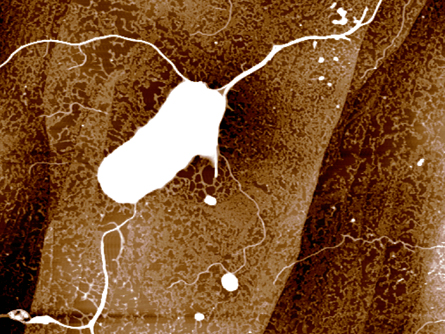- More than 2 years ago
Like a household wire carries electrons from wall socket to appliance, bacteria can conduct electricity along tiny wire-like appendages, researchers report online October 11 in the Proceedings of the National Academy of Sciences.

A community of bacteria connected by these gangly nanowires could act as a slimy fuel cell, digesting organic matter and churning out electricity. If a wired-up community of bacteria could be coaxed into participating, the microbes might also gobble up toxic marine sediments or process sewage at waste treatment plants.
Biologists first noticed that deep-sea bacteria grew the curious wires when placed in environments with little oxygen. Rather than suffocate, the microbes grew nanowires made of protein to hunt for pockets of oxygen or other places to dump electrons, says biologist Yuri Gorby at the J. Craig Venter Institute in San Diego. Then the bacteria appeared to share the gas — their way of breathing — by connecting their wires, as if a crowded room of people could breathe from an open window simply by linking hands.
The scientists had suspected that nanowires can carry electrons, but struggled to create instruments nimble enough to measure the current without destroying the fragile conduits. Now, with nanotech tools, researchers led by Mohamed El-Naggar of the University of Southern California in Los Angeles have shown that wired-up bacterial communities can act like circuits.
Using a powerful microscope to find the bacteria, called Shewanella, the researchers pricked the microbes’ nanowires with platinum electrodes to measure the current flow and found that one billion electrons travel through the wires every second. The current isn’t as strong as in a copper wire, but it’s enough to support a cell’s daily grind of consuming food for energy and spitting electrons back out.
“That these old organisms seem to develop their own electrical distribution system is really amazing,” said Gorby. “We’ve only known about electricity for 200 years, but we’re hypothesizing they’ve been doing it for billions of years.”
The research doesn’t prove that the bacteria actually exploit their spaghetti-like electronics system, just that they have the capacity to do so. The next step, the researchers say, is to understand how the bacteria work as a community.
Colonies of the creatures could use cellular respiration to generate electricity. At sewage treatment plants, the bacteria could actually help power the facility, says environmental engineer Bruce Logan at Pennsylvania State University in University Park.
“It may not solve all of our energy problems, but it would go a long way to solve our water energy problems,” Logan says. Waste treatment consumes about 5 percent of the U.S. electrical bill, he says.
Bacteria are attractive candidates as alternative energy sources because they’re cheap and easy to maintain, says Gorby. An electrode surface is needed to catch the electrons, but the bacteria could do jobs such as decomposing ocean sediments or breaking down methane emitted by rice paddies.
“What’s driving this field is the need for creating new and renewable energy technologies,” says Logan.






